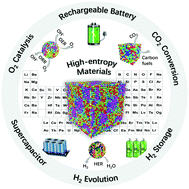High-entropy energy materials: challenges and new opportunities
Abstract
The essential demand for functional materials enabling the realization of new energy technologies has triggered tremendous efforts in scientific and industrial research in recent years. Recently, high-entropy materials, with their unique structural characteristics, tailorable chemical composition and correspondingly tunable functional properties, have drawn increasing interest in the fields of environmental science and renewable energy technology. Herein, we provide a comprehensive review of this new class of materials in the energy field. We begin with discussions on the latest reports on the applications of high-entropy materials, including alloys, oxides and other entropy-stabilized compounds and composites, in various energy storage and conversion systems. In addition, we describe effective strategies for rationally designing high-entropy materials from computational techniques and experimental aspects. Based on this overview, we subsequently present the fundamental insights and give a summary of their potential advantages and remaining challenges, which will ideally provide researchers with some general guides and principles for the investigation and development of advanced high-entropy materials.

- This article is part of the themed collections: Energy and Environmental Science Recent Review Articles and Battery science and technology – powered by chemistry


 Please wait while we load your content...
Please wait while we load your content...